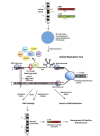DNA instability at chromosomal fragile sites in cancer
- PMID: 21286310
- PMCID: PMC2944998
- DOI: 10.2174/138920210791616699
DNA instability at chromosomal fragile sites in cancer
Abstract
Human chromosomal fragile sites are specific genomic regions which exhibit gaps or breaks on metaphase chromosomes following conditions of partial replication stress. Fragile sites often coincide with genes that are frequently rearranged or deleted in human cancers, with over half of cancer-specific translocations containing breakpoints within fragile sites. But until recently, little direct evidence existed linking fragile site breakage to the formation of cancer-causing chromosomal aberrations. Studies have revealed that DNA breakage at fragile sites can induce formation of RET/PTC rearrangements, and deletions within the FHIT gene, resembling those observed in human tumors. These findings demonstrate the important role of fragile sites in cancer development, suggesting that a better understanding of the molecular basis of fragile site instability is crucial to insights in carcinogenesis. It is hypothesized that under conditions of replication stress, stable secondary structures form at fragile sites and stall replication fork progress, ultimately resulting in DNA breaks. A recent study examining an FRA16B fragment confirmed the formation of secondary structure and DNA polymerase stalling within this sequence in vitro, as well as reduced replication efficiency and increased instability in human cells. Polymerase stalling during synthesis of FRA16D has also been demonstrated. The ATR DNA damage checkpoint pathway plays a critical role in maintaining stability at fragile sites. Recent findings have confirmed binding of the ATR protein to three regions of FRA3B under conditions of mild replication stress. This review will discuss recent advances made in understanding the role and mechanism of fragile sites in cancer development.
Keywords: ATR checkpoint pathway; DNA secondary structure; RET/PTC rearrangement; cancer-specific chromosomal translocation; environmental mutagen; fragile site; stalled replication fork..
Figures

References
-
- Jackson S P. Sensing and repairing DNA double-strand breaks. Carcinogenesis. 2002;23:687–96. - PubMed
-
- O'Keefe L V, Richards R I. Common chromosomal fragile sites and cancer: focus on FRA16D. Cancer Lett. 2006;232:37–47. - PubMed
-
- Richards R I. Fragile and unstable chromosomes in cancer: causes and consequences. Trends Genet. 2001;17:339–345. - PubMed
-
- Popescu N C. Genetic alterations in cancer as a result of breakage at fragile sites. Cancer Lett. 2003;192:1–17. - PubMed
-
- Yunis J J, Soreng A L. Constitutive fragile sites and cancer. Science. 1984;226:1199–1204. - PubMed
Grants and funding
LinkOut - more resources
Full Text Sources
Other Literature Sources
Miscellaneous
